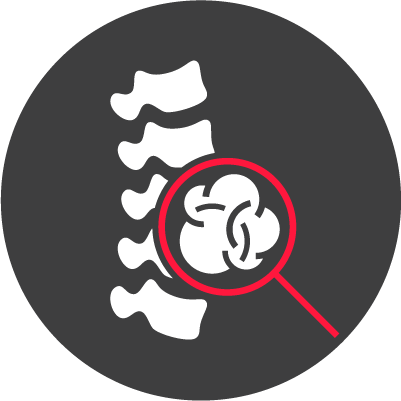“CFRP pedicle screws reduce image artifacts on CT and MRI. Thereby, they are a valuable and feasible option for spinal instrumentations in patients harboring spinal tumors where postoperative imaging and radiation therapy planning are necessary and might be crucial for long-term outcome and overall survival.”
Aftercare – the Key to Effective
Tumor Monitoring
Tumor therapy includes surgical stabilization of the spine and radiation therapy as well as aftercare. Effective treatment also includes reliable, long-term tumor monitoring.
The continuous improvement of oncological therapy concepts is having a positive effect on long-term patient outcomes. The life expectancy of patients with neoplasms has increased significantly in recent years. In this context, the importance of aftercare has also clearly increased. BlackArmor® Carbon/PEEK implants also contribute to this. The material properties expand the diagnostic and therapeutic options, which optimizes aftercare.

Early Recurrence Detection
BlackArmor® Carbon/PEEK facilitates early recurrence detection1Ringel et al. (2017): Radiolucent Carbon Fiber-Reinforced Pedicle Screws for Treatment of Spinal Tumors: Advantages for Radiation Planning and Follow-Up Imaging. World Neurosurgery. (PubMed, PMID: 28478252)2Almeida et al. (2022): Carbon Fiber Reinforced PEEK Implants for Spine Tumors: A Single Center Experience. The Spine Journal, Volume 22, Issue 9, Supplement, Page S185 (Link)due to its radiolucency, expanding therapy options for patients. If recurrences are detected in routine postoperative monitoring and still in the asymptomatic stage, emergency situations can be prevented. Additionally, systemic therapy can be adapted earlier, and local treatment options are increased and easier on the patient.

More Confident Decision-Making
Follow-ups are essential for effective tumor monitoring. With reduced imaging quality, decisions regarding further therapeutic steps are significantly more difficult and fraught with uncertainty. BlackArmor® Carbon/PEEK implants reduce artifacts, making postoperative imaging assessment easier.1Ringel et al. (2017): Radiolucent Carbon Fiber-Reinforced Pedicle Screws for Treatment of Spinal Tumors: Advantages for Radiation Planning and Follow-Up Imaging. World Neurosurgery. (PubMed, PMID: 28478252)3Fleege et al. (2020): Carbon-Fiber-Reinforced Pedicle Screws Reduce Artifacts in Magnetic Resonance Imaging of Patients with Lumbar Spondylodesis. Scientific Reports. (PubMed, PMID: 32999385)4Krätzig et al. (2021): Carbon-Fiber-Reinforced PEEK versus Titanium Implants: An In Vitro Comparison of Susceptibility Artifacts in CT and MR Imaging. Neurosurgical Review. (PubMed, PMID: 32930911)

Optimized MRI-Based Follow-up
Titanium implants create a significant amount of susceptibility artifacts on MR-based imaging, often leading to a non-diagnostic examination. With BlackArmor® Carbon/PEEK implants, these artifacts are significantly reduced allowing for optimal visualization of local tumor control as well as radiation planning and delivery.1Ringel et al. (2017): Radiolucent Carbon Fiber-Reinforced Pedicle Screws for Treatment of Spinal Tumors: Advantages for Radiation Planning and Follow-Up Imaging. World Neurosurgery. (PubMed, PMID: 28478252)4Krätzig et al. (2021): Carbon-Fiber-Reinforced PEEK versus Titanium Implants: An In Vitro Comparison of Susceptibility Artifacts in CT and MR Imaging. Neurosurgical Review. (PubMed, PMID: 32930911)5Kalasauskas et al. (2022): Qualitative Assessment of Titanium versus Carbon Fiber/Polyetheretherketone Pedicle Screw-Related Artifacts: A Cadaveric Study. World Neurosurgery. (PubMed, PMID: 35803562)